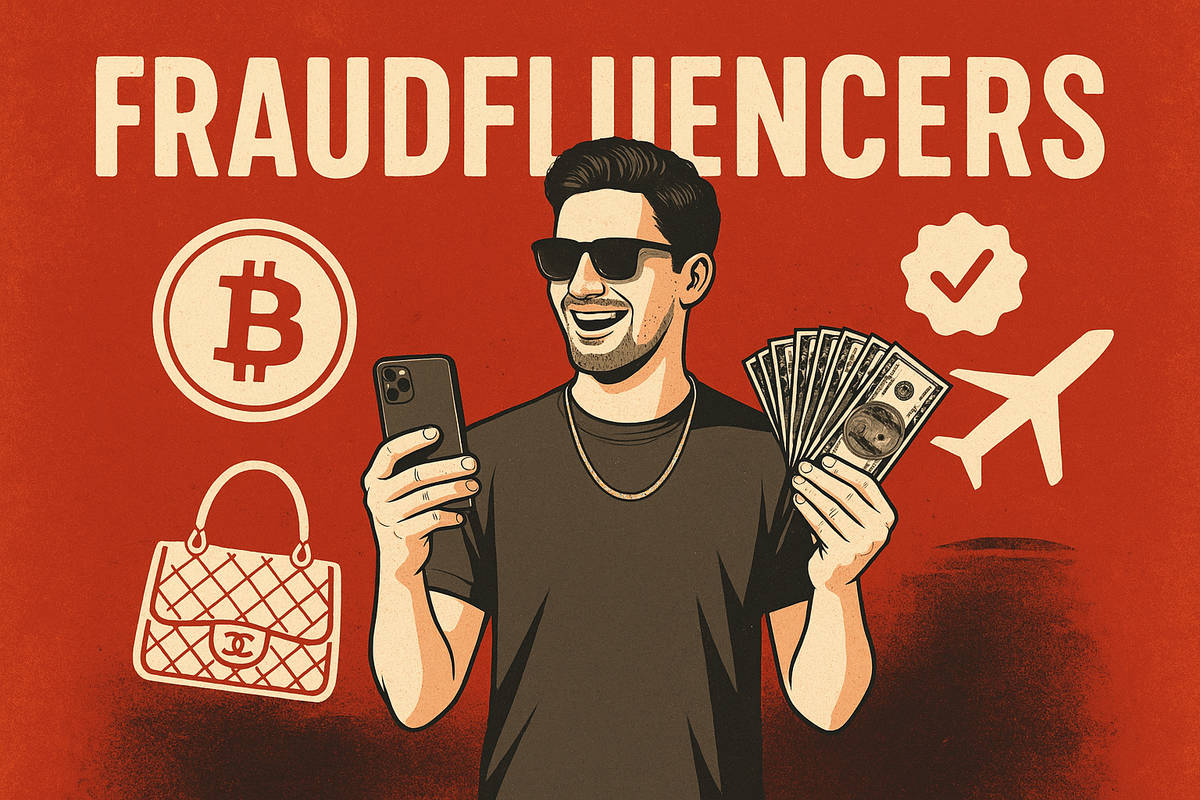When Influencers Go Criminal: The Rise of Fraudfluencers
A new breed of “fraudfluencers” is exploiting social media fame to run scams, from fake investments to counterfeit products, costing followers millions and eroding trust in online communities.

Introduction
Long ago, the blue checkmark signified reliability. A verified badge guaranteed that you were following an actual, prominent individual an expert, a tastemaker, a reliable voice. Now, that same badge is increasingly a warning sign. In 2024 and 2025, the world has experienced a chilling increase in "fraudfluencers" social media influencers who use their huge followings not only for advertising, but for criminal purposes. With crypto rug pulls and fake luxury items to fictitious travel partnerships, the age of social veneer scams is in full swing.
This article brings you inside the phenomenon, revealing how influencers-turned-scam-artists use trust, what fraudsters are most prevalent, and why the platforms themselves have faltered or failed to prevent them.
Section 1: The Perfect Storm of Influence and Deception
Influencers succeed because they capitalize on parasocial relationships—unevenly reciprocal ones in which the fans themselves feel personally attached. That closeness powers consumer trust and drives conversion rates through the roof. But it also leaves fans particularly exposed to exploitation.
Three conditions have made fraudfluencers unavoidable:
- Easy Monetization: Sites such as Instagram, TikTok, and YouTube have integrated monetization features, but they also facilitate covert sponsorship arrangements. Several brands and creators deal in private messages or verbal agreements, which are nearly impossible for authorities to inspect.
- Verification Inflation: Previously limited to public individuals, verification is now a commodity. On social platforms such as X (formerly Twitter), you can actually purchase a blue tick. This inflation makes it more difficult for users to recognize a real authority from a scammer posing as that person.
- Hype-Driven FOMO: Web3, fast fashion, and influencer travel all thrive on urgency. Limited drops, limited collabs, and "once-in-a-lifetime investments" are exactly the tools con artists have exploited for decades—just rebranded in hashtags and Stories.
As of a 2024 Google Trends analysis, searches for "influencer scam" hit a five-year peak, up 278% following several high-profile cases of scams. (Google Trends, 2024)
Section 2: Crypto Rug Pulls : When Memecoins Become Mega Scams
Few industries have been so thoroughly penetrated by fraudfluencers as cryptocurrency. The emergence of "shitcoins" and meme tokens created a gold rush one that was driven by celebrity endorsements and social media hype.
Rug pulls—where developers hype the price of a coin, then disappear after selling out became the go-to play for influencer scammers.
Case Example: SaveTheKids Token
Some gaming YouTubers in mid-2021 endorsed SaveTheKids, a token with a charity theme. They stated proceeds would be directed to children's charities. The price of the token plummeted more than 90% within days of release,Blockchain detectives found that the founders and promoters had arranged huge dumps early on. (Justia, 2022 court filings)
How They Did It:
- Emotional Appeal: "Helping kids" as the hook
- FOMO: Short pre-sale windows
- Social Proof: Dozens of large accounts endorsement at once
Although the SaveTheKids scandal is notorious, it set the bar high. During 2022–2024, influencers hawked dozens of identical tokens each with promises of financial upheaval but delivering exit scams.
Warning Signs of Crypto Influencer Scams:
- No apparent development team
- No third-party audit
- Incomplete or unclear whitepapers
- Resale restriction contracts (so that founders can dump on you)
- Limited-time presales with urgency to "act now"
Section 3: The Luxury Fake Epidemic
Yet another booming fake economy is fake luxury. Authenticated influencers flaunt Hermès, Gucci, or Rolex asserting that they acquired "wholesale access" or "factory-direct pricing." The actual secret? These products are imitation high-end products, produced in China, and shipped discreetly so that they won't get seized by customs.
In 2023, the U.S. Customs and Border Protection seized more than $2 billion worth of counterfeit merchandise, a record. Social media led much of the demand. (Official press release, CBP.gov, 2023)
How the Scam Works:
- Influencer purchases 2–3 genuine items to establish credibility.
- They create staged unboxings and include brands to suggest endorsement.
- They covertly begin selling copies, stating they're "sample stock" or "factory surplus."
- Because buyers trust the influencer, they rarely request authentication certificates.
Some fraudfluencers even create elaborate websites with stolen brand imagery. A recent Archive.org investigation showed how one Instagram account linked to 15 different fake storefronts, all promising “authentic” Chanel bags at a 70% discount.
Section 4: Sham Travel Collabs and Phantom Retreats
The travel industry, already battered by the pandemic, has become fertile ground for scammy influencer schemes:
- Paid Retreats That Never Materialize: Influencers take deposits for "transformational" wellness retreats and then cancel without refunding.
- "Collab" Trips: Bogus brands target small influencers with offers of free trips if they pay "taxes and fees" upfront.
- Timeshare Scams: Influencers pose as "ambassadors" for high-end resorts, taking finder's fees for timeshare presentations that trap victims into predatory contracts.
Example: The Bali "Wellness" Retreat Scam
In 2024, a Bali getaway hyped by a mid-range wellness influencer was suddenly canceled after they took more than $200,000 in deposits. Victims found that the resort didn't even exist. CourtListener documents indicate the influencer was subsequently included in a civil complaint for fraud. (CourtListener Docket 4:24-cv-01567)
That's why experts recommend that consumers:
- Double-check resorts independently
- Demand contracts
- Pay with credit cards for deposit protection
- Be wary of "last-minute availability" at deep discounts
Section 5: Why Platforms Are Failing to Stop Them
You’d think that massive platforms with billions in revenue could stamp out fraud. But several factors work against effective enforcement:
- Decentralized Commerce: Much of the scamming happens off-platform through Telegram, WhatsApp, or private payment links.
- Volume Overwhelm: Meta, TikTok, and X rely on automated moderation. These tools are easily evaded with code words, emojis, and limited-time Stories.
- Monetary Incentives: Sites make money from transaction fees and advertising revenue. A few have been accused of turning a blind eye.
- Jurisdictional Complexity: Influencers can live in one jurisdiction, host their payment gateway in another jurisdiction, and target victims globally.
Section 6: The Psychology of Fraudfluence
To determine why fraudfluencers are successful, you must understand human psychology:
- Authority Bias: The blue check is a stamp of authority.
- Bandwagon Effect: If all the people you follow are hyping something, it must be legit.
- Reciprocity: Influencers provide free content, advice, and entertainment—so you owe it to them to believe them.
- Scarcity: Low quantities and countdown timers evoke impulse choices.
Stack these triggers with image-heavy lifestyles expensive vacations, sports cars, designer attire and it's simple to see why regular folks get dragged along.
Section 7: What Regulators Are Doing—And What You Can Do
Governments are beginning to push back:
- The FTC has just set out rules demanding open disclosure of any material relationship to goods or services. (Official FTC Press Release, 2024)
- Regulators in Europe have penalized influencers promoting unlicensed financial products.
- An American Congressional committee has launched investigations into Instagram and TikTok's failure to enforce fraud. (Responsible news coverage, The Washington Post, 2025)
But enforcement crawls and scams spread faster than regulation. Here's how you can guard against them:
- Demand Proof: Require official invoices, contracts, and authenticity certificates.
- Pay Safely: Use credit cards or payment processors with fraud protection.
- Research Deeply: Look up any business on government registries. Use Archive.org to see website histories.
- Watch for Hype: If an offer seems too good to be true, it probably is.
- Report Suspicious Activity: Flag scam content to the platform and, if you’ve lost money, file complaints with your country’s consumer protection agency.
Section 8: The Future of Influence—Transparency or Turmoil?
Influencer marketing isn't disappearing. But the blind-trust heyday is done. Platforms, regulators, and viewers are all realizing that fame doesn't equal integrity.
In the next few years, experts see:
- Verified audits of influencer businesses
- Blockchain-based proof of transactions
- Public registries of banned or penalized accounts
- AI tools that can identify coordinated scams across accounts
In the meantime, consumers have to be healthy skeptics. Not that you should distrust every creator. But in a world of endemic fraud, it is up to each of us to do our research before we invest.
Conclusion
Fraudfluencers are the dark side of social media fame where influence is used as a tool and trust is turned into a burden. The next time you notice a blue tick getting you all excited about a "life-changing" investment or an "exclusive" high-end deal, think again. Research. Ask for receipts.
Because in 2025, the scariest scams don't come to your inbox they creep into your feed.
Sources
- CourtListener. SaveTheKids Securities Fraud Docket. https://www.courtlistener.com/docket/59227497/savethekids-securities-fraud/
- Justia. Crypto Token Fraud Litigation. https://dockets.justia.com/docket/crypto-token-fraud
- U.S. Customs and Border Protection. CBP Reports Record Seizures of Counterfeit Goods, 2023. https://www.cbp.gov/newsroom/national-media-release/cbp-reports-record-seizures
- Archive.org. Historical Snapshots of Influencer Scam Websites. https://web.archive.org/
- Google Trends. Influencer Scam Searches. https://trends.google.com/
- Federal Trade Commission. New Endorsement Guidelines Proposal, 2024. https://www.ftc.gov/news-events/press-releases/2024/03/ftc-proposes-new-guidelines
- The Washington Post. Congress Probes Social Media’s Role in Fraud, 2025. https://www.washingtonpost.com/technology/2025/04/15/influencer-fraud-investigation/
For more legal exposes and truth-behind-glamour stories, subscribe to AllegedlyNewsNetwork.com




